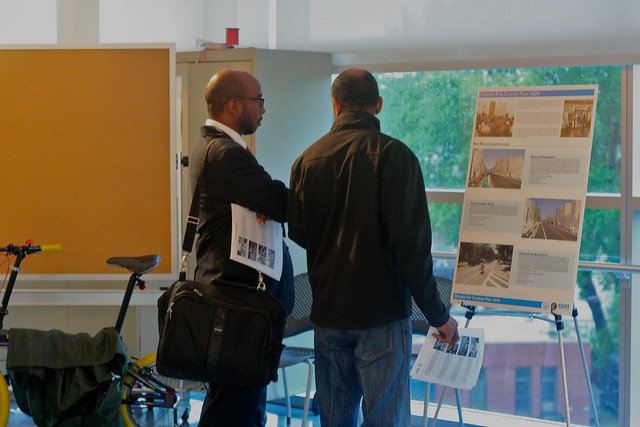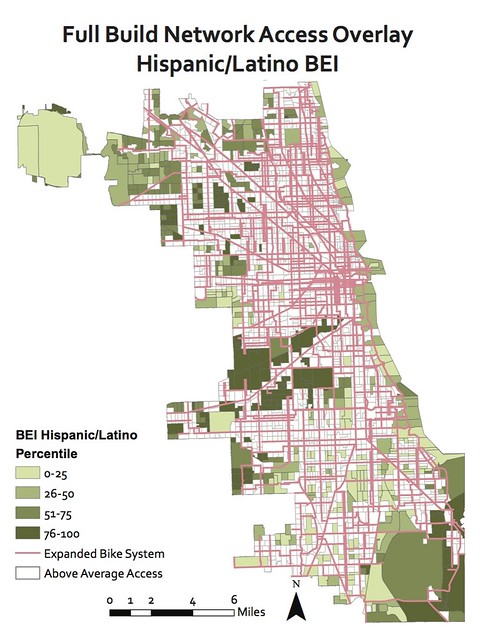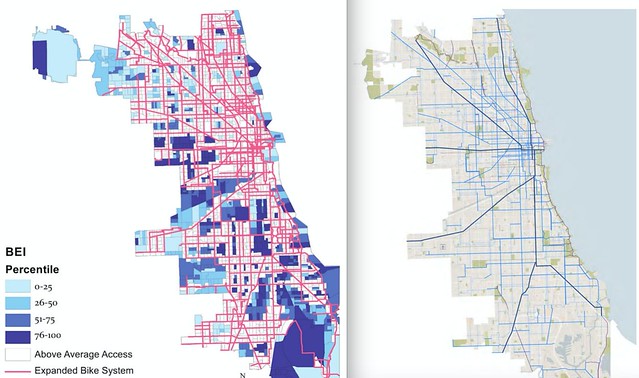
Earlier this month, the League of American Bicyclists released a report with a method for exploring how well bike networks provide access to underserved communities. Using Chicago as a case study, the report found that our city’s “planned network” would provide African-American and Latino neighborhoods with less than their fair share of access to bike lanes and paths.
However, the map that the report analyzed was not actually a map of Chicago’s planned bike network. After Streetsblog Chicago ran two posts drawing attention to the problem, the League has finally overhauled the report using the correct data. As a result, the study now finds Chicago’s Streets for Cycling Plan 2020 would significantly improve access for communities of color.
The report, “Equity of Access to Bicycle Infrastructure,” was written by Rachel Prelog, a Colorado-based urban planning grad student. Using data from the city of Chicago’s geographic information system portal, Prelog analyzed what she thought was the network of proposed streets for new bikeways.
Although the 2020 Plan was created after an extensive public input process, with the goal of creating a network that serves all Chicagoans equitably, Prelog's original report suggested that the effort was a failure. She wrote that African Americans would “account for a large proportion of the residents who would not benefit from the expanded system."
Worse, she wrote, “The full build bicycle network… would do little to improve access for Chicago’s Hispanic/Latino community.” She stated that the network would only provide one percent more of Chicago’s Latino population with quarter-mile access to bicycle paths and lanes.
However, the “planned network” map that Prelog analyzed was actually based on “recommended routes” shown on the city’s Chicago Bike Map, distributed for free at events and shops. Many of these routes don’t appear on the 2020 Plan map, and many of the 2020 Plan routes don’t appear on the Chicago Bike Map.
Soon after the study came out, I posted about the map problem, and called for the League to overhaul the report with the correct data. In response, they simply added a few disclaimers to the document to say the maps reflected “the data available at the time of this report.” However, at no point in time did the city’s database classify the recommended routes shown on Prelog’s map as the “planned network.”

In a follow-up post, I argued that the still-flawed LAB study was harmful because it would undermine support for building Chicago’s bike network, even though its claim that the plan would underserve communities of color was based on bad data. “It’s puzzling why the League won’t simply acknowledge that Prelog made an honest mistake and ask her to plug an accurate map of the 2020 Plan network into the Bike Equity Index model,” I wrote. “Wouldn’t that be more in line with the League’s equity goals than their current strategy of refusing to admit the report needs to be overhauled?”
Thankfully, the League changed their approach. This time, they reached out to the Chicago Department of Transportation to ask for the correct shapefiles for the 2020 Plan network. A statement about the report update on the League’s website notes, “The case study on Chicago now reflects the most up-to-date data related to bicycle infrastructure plans in the city.” The LAB still hasn’t acknowledged that their original report was wrong, but that’s a trivial issue.
Much more importantly, after running an analysis of the real planned network, Perlog found that, rather than disenfranchising communities of color, the 2020 Plan would significantly improve equity. “The full build bicycle network would greatly increase access for Chicago’s Hispanic/Latino community by providing 32 percent more of its population with access to bicycle facilities,” she wrote. “This increased access to bicycle facilities would go a long way towards providing healthy and safe travel options for this community.”
The revised report also states that the new network would provide 32% more of Chicago’s African-American population with access to bikeways. “Furthermore, the implementation of the full build network would reduce the proportion of the African-American population living in underserved areas,” Perlog wrote. “Where they currently account for 35 percent of the population in [areas underserved by the existing network], under the full build network they would only account for 32 percent of the underserved demographic,” she writes.
The revised LAB revised report certainly doesn't prove that the 2020 Plan will resolve Chicago's major bike equity issues. But it does offer some reassurance that the city's bikeway planning efforts are on the right track.




